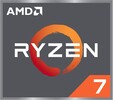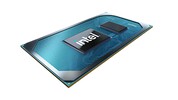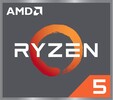AMD Ryzen 7 3700U vs Intel Core i5-1155G7 vs AMD Ryzen 5 3450U
AMD Ryzen 7 3700U
► remove from comparison
The AMD Ryzen 7 3700U is a mobile SoC that was announced in January 2019. It combines four Zen+ cores (8 threads) clocked at 2.3 GHz to 4 GHz with a Radeon RX Vega 10 graphics adapter with 10 CUs (640 shaders) clocked at up to 1,400 MHz. Specified at 15 Watt TDP, the SoC is intended for thin mid-range laptops. In Chromebooks, AMD calles the APU AMD Ryzen 7 3700C, but with the exact same specifications (and performance).
The Picasso SoCs use the Zen+ microarchitecture with slight improvements that should lead to a 3% IPC (performance per clock) improvements.
The integrated dual-channel memory controller supports up to DDR4-2400 memory. As the features of the Picasso APUs are the same compared to the Raven Ridge predecessors, we point to our Raven Ridge launch article.
Performance
The average 3700U in our database is a solid mid-range CPU as of early 2021, its multi-thread benchmark scores matching those of the Core i5-10310U and the Core i5-1035G7 (the Ryzen 5 PRO 3500U is found close nearby as well). This Ryzen 7 is good for more than just binge-watching Netflix and writing e-mails. Just do not expect it to be as fast as a Core i7-11800H.
Thanks to its decent cooling solution and sufficiently high CPU power limits, the ThinkPad E595 is among the fastest laptops powered by the 3700U that we know of. It can be up to 50% faster in CPU-bound workloads than the slowest system featuring the same chip in our database, as of August 2023.
Power consumption
This Ryzen 7 series chip has a default TDP of 15 W (also known as the long-term power limit). This can be changed by a laptop manufacturer to anything between 12 W and 35 W with clock speeds and performance changing accordingly as a result. Either way, that's a little too high to allow for passively cooled designs.
Last but not the least, the Ryzen 7 3700U is manufactured on a 12 nm process for lower-than-average, as of mid-2023, energy efficiency.
Intel Core i5-1155G7
► remove from comparison
The Intel Core i5-1155G7 is a power efficient quad-core SoC for laptops and Ultrabooks based on the Tiger Lake-U generation that was announced in mid 2021 as part of the refresh. It integrates four Willow Cove processor cores (8 threads thanks to HyperThreading). The base clock speed depends on the TDP settings and ranges from 1 GHz (12 Watt TDP) up to 2.5 GHz (28 Watt). Boost clock speed is 4.5 GHz.
Tiger Lake SoCs add PCIe 4 support (4 lanes), AI hardware acceleration, and the partial integration of Thunderbolt 4 / USB 4 and Wifi 6 in the chip.
Another novelty is the integrated Xe graphics adapter with 80 EUs based on the completely new Gen 12 architecture. It offers a significantly higher performance compared to the older Iris Plus G7 (Ice Lake).
Performance
The average 1155G7 in our database proves to be a very decent mid-range processor, as of mid 2022, trading blows with the Core i7-10810U and the Ryzen 5 4500U as far as multi-thread benchmark scores are concerned. While perhaps not the best option for power users, this Core i5 will make most consumers happy, providing for short load times and generally pain-free experience.
Your mileage may vary depending on how high the CPU power limits are and how competent the cooling solution of your system is.
Power consumption
This Core i5 series chip has a default TDP, also known as the long-term power limit, of 12 W to 28 W, the expectation being that laptop makers will go for a higher value in exchange for higher performance. Either way, this is a tad too high to allow for passively cooled designs.
The i5-1155G7 is built with Intel's third-gen 10 nm process marketed as SuperFin for lower-than-average, as of early 2023, energy efficiency.
AMD Ryzen 5 3450U
► remove from comparison
The AMD Ryzen 5 3450U is a mobile SoC that was announced in Q2 2020 as a refresh. It combines four Zen+ cores (8 threads) clocked at 2.1 GHz to 3.5 GHz (-200 MHz versus 3500U) with a Radeon RX Vega 8 iGPU with 8 CUs (512 Shaders) clocked at up to 1200 MHz.
The Picasso SoC uses the Zen+ microarchitecture with slight improvements that should lead to a 3% IPS (performance per clock) improvements. Furthermore, the 12 nm process allows for higher clocks at similar power consumption.
The integrated dual-channel memory controller supports up to DDR4-2400 memory. As the features of the Picasso APUs are the same compared to the Raven Ridge predecessors, we point to our Raven Ridge launch article.
Performance
The average 3450U in our database is in the same league as the Core i3-1115G4 and also the Ryzen 3 4300U, as far as multi-thread benchmark scores are concerned. This is a better-than-expected result for an aging lower mid-range chip that is the 3450U, as of mid 2022.
Your mileage may vary depending on how high the CPU power limits are and how competent the cooling solution of your system is.
Power consumption
The Ryzen 5 has a default TDP (also known as the long-term power limit) of 15 W, a value that laptop manufacturers are allowed to change to anything between 12 W and 35 W if required with clock speeds and performance changing correspondingly. These values are fairly high, making active cooling solutions something of a necessity.
The CPU is built with a somewhat old, as of late 2022, 12 nm process for lower-than-average energy efficiency.
| Model | AMD Ryzen 7 3700U | Intel Core i5-1155G7 | AMD Ryzen 5 3450U | ||||||||||||||||||||||||||||||||||||||||||||||||||||||||||||||||||||||||||||||||
| Codename | Picasso-U (Zen+) | Tiger Lake-UP3 | Picasso-U (Zen+) | ||||||||||||||||||||||||||||||||||||||||||||||||||||||||||||||||||||||||||||||||
| Series | AMD Picasso (Ryzen 3000 APU) | Intel Tiger Lake | AMD Picasso (Ryzen 3000 APU) | ||||||||||||||||||||||||||||||||||||||||||||||||||||||||||||||||||||||||||||||||
| Series: Picasso (Ryzen 3000 APU) Picasso-U (Zen+) |
|
|
| ||||||||||||||||||||||||||||||||||||||||||||||||||||||||||||||||||||||||||||||||
| Clock | 2300 - 4000 MHz | 2500 - 4500 MHz | 2100 - 3500 MHz | ||||||||||||||||||||||||||||||||||||||||||||||||||||||||||||||||||||||||||||||||
| L1 Cache | 384 KB | 320 KB | 384 KB | ||||||||||||||||||||||||||||||||||||||||||||||||||||||||||||||||||||||||||||||||
| L2 Cache | 2 MB | 5 MB | 2 MB | ||||||||||||||||||||||||||||||||||||||||||||||||||||||||||||||||||||||||||||||||
| L3 Cache | 4 MB | 8 MB | 4 MB | ||||||||||||||||||||||||||||||||||||||||||||||||||||||||||||||||||||||||||||||||
| Cores / Threads | 4 / 8 | 4 / 8 | 4 / 8 | ||||||||||||||||||||||||||||||||||||||||||||||||||||||||||||||||||||||||||||||||
| TDP | 15 Watt | 28 Watt | 15 Watt | ||||||||||||||||||||||||||||||||||||||||||||||||||||||||||||||||||||||||||||||||
| Transistors | 4500 Million | 4500 Million | |||||||||||||||||||||||||||||||||||||||||||||||||||||||||||||||||||||||||||||||||
| Technology | 12 nm | 10 nm | 12 nm | ||||||||||||||||||||||||||||||||||||||||||||||||||||||||||||||||||||||||||||||||
| max. Temp. | 105 °C | 100 °C | 105 °C | ||||||||||||||||||||||||||||||||||||||||||||||||||||||||||||||||||||||||||||||||
| Socket | FP5 | BGA1449 | FP5 | ||||||||||||||||||||||||||||||||||||||||||||||||||||||||||||||||||||||||||||||||
| Features | DDR4-2400, PCIe 3, MMX, SSE, SSE2, SSE3, SSSE3, SSE4A, SSE4.1, SSE4.2, AVX, AVX2, BMI2, ABM, FMA, ADX, SMEP, SMAP, SMT, CPB, AES-NI, RDRAND, RDSEED, SHA, SME | DDR4-3200/LPDDR4x-4266 RAM, PCIe 4, 4 GT/s bus, DL Boost, GNA, MMX, SSE, SSE2, SSE3, SSSE3, SSE4.1, SSE4.2, AVX, AVX2, AVX-512, BMI2, ABM, FMA, ADX, VMX, SMEP, SMAP, EIST, TM1, TM2, HT, Turbo, SST, AES-NI, RDRAND, RDSEED, SHA | DDR4-2400 RAM, PCIe 3, MMX, SSE, SSE2, SSE3, SSSE3, SSE4A, SSE4.1, SSE4.2, AVX, AVX2, BMI2, ABM, FMA, ADX, SMEP, SMAP, SMT, CPB, AES-NI, RDRAND, RDSEED, SHA, SME | ||||||||||||||||||||||||||||||||||||||||||||||||||||||||||||||||||||||||||||||||
| iGPU | AMD Radeon RX Vega 10 ( - 1400 MHz) | Intel Iris Xe Graphics G7 80EUs (400 - 1350 MHz) | AMD Radeon RX Vega 8 (Ryzen 2000/3000) ( - 1200 MHz) | ||||||||||||||||||||||||||||||||||||||||||||||||||||||||||||||||||||||||||||||||
| Architecture | x86 | x86 | x86 | ||||||||||||||||||||||||||||||||||||||||||||||||||||||||||||||||||||||||||||||||
| Announced | |||||||||||||||||||||||||||||||||||||||||||||||||||||||||||||||||||||||||||||||||||
| Manufacturer | www.amd.com | ark.intel.com | www.amd.com |
Benchmarks
Average Benchmarks AMD Ryzen 7 3700U → 100% n=16
Average Benchmarks Intel Core i5-1155G7 → 175% n=16
Average Benchmarks AMD Ryzen 5 3450U → 97% n=16
* Smaller numbers mean a higher performance
1 This benchmark is not used for the average calculation













